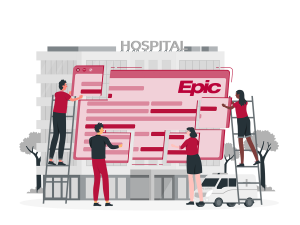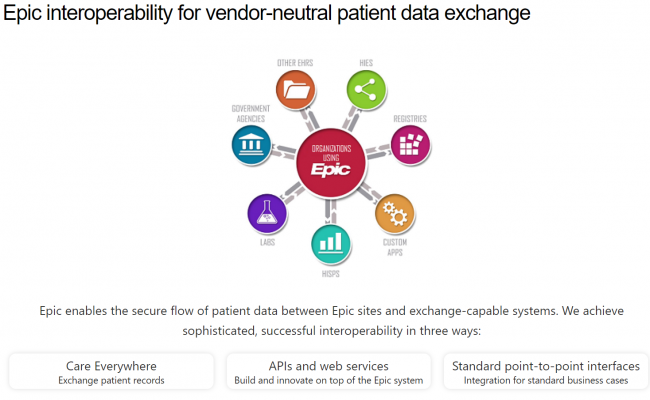
In the healthcare industry, the importance of data interoperability – the ability of systems and devices to exchange and interpret shared data – can’t be overstated. In this era of digital transformation, the Fast Healthcare Interoperability Resources (FHIR) standard is playing a crucial role in facilitating interoperability and shaping the future of healthcare data exchange.
At the forefront of these developments is Epic Systems, with its leading Electronic Health Record (EHR) and Electronic Medical Record (EMR) solutions which incorporate Health Level Seven International (HL7) and FHIR standards to maximize the potential of interoperable data. This critical alignment not only contributes to seamless data exchange but also ensures the protection of patient health information (PHI), a requirement under the Health Insurance Portability and Accountability Act (HIPAA).
As a leading Seattle-based healthcare software development company, Itirra is deeply involved in these dynamics. With a clear focus on leveraging FHIR and other advanced standards, we aid healthcare organizations to unlock the interoperability potential of their Epic EHR systems. This article offers a comprehensive view into the world of Epic FHIR app development, providing insights into how these applications enhance the functionality of Epic’s EHR system, help ensure HIPAA compliance, and ultimately improve care delivery.
What is the relationship between Epic and FHIR?
The FHIR standard, established by HL7, has been a transformative element in modern healthcare. FHIR’s application programming interface (API) framework facilitates the exchange of healthcare information in a standardized and secure manner, contributing significantly to HITRUST’s goal of secure and compliant data exchange. It enables the seamless integration of discrete healthcare data sets (such as laboratory results, medication records, and patient demographics) from disparate systems, ensuring that critical PHI is readily accessible whenever and wherever it’s needed.
Epic Systems, with its dedication to enhancing patient care and operational efficiency, has been a proactive adopter of the FHIR standard. Epic’s EHR and EMR solutions are designed to work in conjunction with FHIR to deliver interoperable healthcare applications. This compatibility allows healthcare providers to unlock and share PHI securely and efficiently, both within and across healthcare systems, enhancing coordinated care and contributing to better patient outcomes.
Epic’s FHIR APIs allow external applications to retrieve data stored in Epic’s EHR system and even write back data into the system when appropriate. This level of integration supports the development of innovative applications that enhance the functionality of Epic’s EHR system. Additionally, these applications are designed to comply with the rigorous security standards outlined in HIPAA, further ensuring the safe handling of PHI.
In essence, the relationship between Epic and FHIR is synergistic. Epic’s robust EHR and EMR solutions, combined with the flexibility and interoperability facilitated by FHIR, provide healthcare organizations with the tools they need to deliver efficient, effective, and patient-centered care. And, as a leading player in healthcare software development, Itirra stands at the forefront of this transformative integration, delivering Epic FHIR app solutions that address the unique needs and goals of healthcare organizations.

An overview of Epic FHIR app development
Developing an Epic FHIR app is a crucial step for healthcare organizations aiming to harness the power of interoperability and maximize their use of Epic’s robust EHR system. This process involves several important steps and prerequisites, and leveraging the right tools and following best practices can help ensure success.
Before embarking on Epic FHIR app development, it’s essential to have a thorough understanding of both the FHIR standard and the specific capabilities and nuances of Epic’s EHR system. Familiarity with HITRUST protocols, as well as the HIPAA regulations that govern the handling of PHI, is equally crucial. Knowledge of these standards and regulations forms the foundation for developing an app that is not only functional and interoperable but also secure and compliant.
The process of Epic FHIR app development is an involved one that requires both technical expertise and strategic planning. It typically follows these steps:
Definition of the app’s functionality
The initial phase involves a comprehensive understanding of the app’s intended functionality. This is crucial for setting the direction of the development project. This may involve consulting with healthcare professionals to understand the needs and challenges that the app should address.
Identification of use cases
Once the functionality is defined, developers identify specific use cases within the healthcare setting. This stage requires a deep understanding of healthcare workflows, and may involve developing patient or practitioner personas, mapping out user journeys, and identifying key interactions with the Epic EHR system.
Design phase
Following this, the design phase begins, which includes creating the app’s UI/UX, defining the app’s architecture, and planning how the app will interact with Epic’s EHR system and other systems if necessary.
Coding phase
Next, the application itself is developed. This process should be carried out by developers who are not only experienced in app development, but also have a deep understanding of the FHIR standard and Epic’s system.
Testing
Once the application is coded, rigorous testing is conducted to ensure that the app works as expected, is secure, and can efficiently and accurately exchange data using FHIR standards.
Deployment and Maintenance
After successful testing, the app is deployed. However, the work doesn’t stop there. Continuous monitoring and maintenance are crucial to ensure ongoing compliance with FHIR standards, and to address any emerging needs or issues.
The development process is supported by a range of tools and resources. Epic provides its developer community with the Epic FHIR APIs and documentation, which provide a comprehensive guide to the data types and services available for use in app development. Additionally, HL7 offers a wealth of resources related to the FHIR standard, including detailed specification documents, online tutorials, and forums for community support.
Developing Epic FHIR apps can be complex, but with the right knowledge, tools, and approach, these apps can unlock new levels of efficiency and patient care. As a leading developer of healthcare software, Itirra has the expertise to guide healthcare organizations through this process and deliver Epic FHIR apps that are secure, compliant, and tailor-made to meet the unique needs of each organization.

Best practices for Epic FHIR app development
The development of an Epic FHIR app is a meticulous process that involves several best practices to ensure the efficient functioning and security of the app. By adhering to the following approaches, healthcare organizations can develop an Epic FHIR app that is not only functionally robust and user-friendly but also ensures data security and regulatory compliance.
Adhering to the principle of "least privilege" in data access
One of the cornerstone best practices is adhering to the “least privilege” principle in data access. This means that the application should only access the minimum amount of PHI necessary to fulfill its functions. This approach reduces the risk of data breaches and ensures that the app is compliant with regulations.
Regular testing within the Epic environment
Another critical practice is to regularly test the app within the Epic environment to ensure it functions correctly. This involves multiple phases of testing, including unit testing, integration testing, and user acceptance testing. Regular testing not only helps in identifying and rectifying bugs early, but it also ensures that the app aligns well with the workflows in the Epic EHR system.
Compliance with security standards
Given the sensitive nature of health data, it is paramount that all data handling within the app complies with the HIPAA and HITRUST standards. This includes implementing secure data transmission protocols, ensuring data encryption at rest and in transit, and maintaining detailed access and activity logs.
Continuous improvement and updating
Healthcare is a dynamic field with continually evolving needs and regulatory updates. Hence, it’s crucial to establish a process for regularly updating the app to incorporate changes in healthcare practices, technological advancements, and regulatory requirements.
Healthcare professionals in development
To ensure that the app meets real-world needs, it’s vital to involve healthcare professionals in the development process. Their insights can help identify key features, eliminate unnecessary functionalities, and streamline workflows in a way that is most beneficial to the end-users.
What are the challenges with Epic FHIR App development?
As exciting as the prospect of developing Epic FHIR apps is, the process is not without its fair share of challenges. Both developers and healthcare organizations need to be aware of these potential pitfalls to plan and manage the development process effectively.
Understanding FHIR specifications
The FHIR standard is complex and continually evolving, requiring a solid understanding of its structure, resources, and terminology. There’s a steep learning curve for developers new to FHIR, which can impact the timeline and quality of the app development process.
Interoperability and compatibility issues
Even with FHIR facilitating interoperability, not all systems use or interpret the standard in the same way. These discrepancies can cause compatibility issues that can be difficult to anticipate and resolve.
Epic EHR system complexity
Epic’s EHR system is vast and intricate, which can pose a challenge to developers unfamiliar with its structure and functionalities. An in-depth understanding of Epic’s APIs, modules, and data flow is crucial for successful FHIR app development.
Data security and compliance
Ensuring the security of PHI and compliance with standards like HITRUST and regulations like HIPAA is a primary concern. Developers must incorporate robust security measures and privacy controls into the app, a process that can be complex and time-consuming.
User experience
The final challenge lies in ensuring that the FHIR app integrates seamlessly into the workflows of healthcare professionals. The app needs to be intuitive, user-friendly, and responsive to the end-users’ needs, requiring constant feedback and iteration.
Conclusion
Epic FHIR app development opens up a world of possibilities for interoperability and improved patient care within the healthcare industry. However, navigating the complexities of FHIR and Epic Systems requires a deep understanding of these tools and the regulatory landscape. This journey is laden with challenges, including grasping complex FHIR specifications, ensuring data security and compliance, managing interoperability issues, and creating a seamless user experience.
However, with the right partner, like Seattle-based healthcare software development company Itirra, these challenges become opportunities. Itirra’s experience and expertise in Epic FHIR app development streamline the process and guarantee the delivery of robust, secure, and user-friendly solutions. In an era where data interoperability can significantly enhance patient outcomes and operational efficiency, investing in Epic FHIR app development guided by seasoned professionals like Itirra becomes an imperative step for healthcare organizations aspiring to lead in the digital health landscape.
The path to unlocking interoperability in healthcare data is here, and Itirra is ready to support your journey. If you’re ready to take the next step in your healthcare organization’s digital transformation, don’t hesitate to contact us for a consultation.
